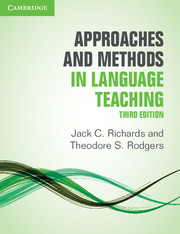Book contents
- Frontmatter
- Contents
- Acknowledgments
- Introduction to the third edition
- I Major trends in twentieth-century language teaching
- II Current approaches and methods
- III Alternative twentieth-century approaches and methods
- IV The teaching and learning environment
- Appendix: Comparison of approaches and methods
- Author index
- Subject index
20 - Teachers, approaches, and methods
Published online by Cambridge University Press: 08 April 2022
- Frontmatter
- Contents
- Acknowledgments
- Introduction to the third edition
- I Major trends in twentieth-century language teaching
- II Current approaches and methods
- III Alternative twentieth-century approaches and methods
- IV The teaching and learning environment
- Appendix: Comparison of approaches and methods
- Author index
- Subject index
Summary
Introduction
We have seen throughout this book that approaches and methods reflect particular assumptions and beliefs about how learners should learn – assumptions that may need to be reviewed based on the roles of autonomous learning, learning strategies, learning style preferences, and technology-mediated learning. Approaches and methods also prescribe how teachers should teach. They reflect assumptions about the nature of good teaching, the practices and techniques teachers should make use of, the teacher's role in the classroom, the kinds of language and resources they should use, and the kinds of grouping arrange-ments and interactions that should occur in their classrooms. When new approaches or methods are introduced, they are promoted as reflecting sound theory and principles and as being the best solution to the language teaching problem. They are often based on the assumption that the processes of second language learning are fully understood. Many of the books written by method gurus are full of claims and assertions about how people learn languages, few of which are based on second language acquisition research or have been empirically tested. Researchers who study language learning are themselves usu-ally reluctant to dispense prescriptions for teaching based on the results of their research, because they know that current knowledge is tentative, partial, and changing. As Atkinson (2011: xi) comments: “It is increasingly apparent … that SLA is an extremely complex and multifaceted phenomenon. Exactly for this reason, it now appears that no single theoretical perspective will allow us to understand SLA adequately.”
Much of SLA research does not support the often simplistic theories and prescriptions found in the literature supporting some approaches and methods. For example, in making their case for CLIL, Coyle, Hood, and Marsh (2010: 153–4) comment:
CLIL has a significant contribution to make not only to providing learners of all ages with motivating experiences which are appropriate for knowledge creation and shar-ing, but also, fundamentally, to cultivating the “cosmopolitan identity” … where learn-ing and using languages for different purposes generates tolerance, curiosity and responsibility as global citizens.
- Type
- Chapter
- Information
- Approaches and Methods in Language Teaching , pp. 346 - 362Publisher: Cambridge University PressPrint publication year: 2014

